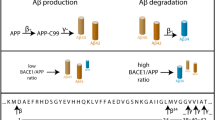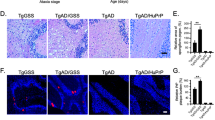Abstract
Ordered assembly of the amyloid-β protein (Aβ) into amyloid fibrils is a critical step in Alzheimer's disease (AD). To release the amyloidogenic peptide Aβ from the Alzheimer amyloid precursor protein (APP), two secretases act sequentially: first, β-secretase cleaves close to the membrane within the ectodomain and then γ-secretase cuts within the transmembrane domain1. The sites of γ-secretase cleavage are after residues 40 or 42 of Aβ. Except in those rare cases of AD caused by a mutation, levels of secreted Aβ are not elevated; thus, the secretory pathway may be unaffected, and factors other than the extracellular concentration of Aβ may contribute to the aggregation properties of the peptide. Aβ is also present in intracellular compartments2–5. The two γ-secretase cleavage products, Aβ42 and Aβ40, were found in different compartments: Aβ42 in the endoplasmic reticulum (ER)/intermediate compartment3–5, and Aβ40 in the trans-Colgi network2,4 (TCN). The cellular compartments that harbor Aβ are target sites for therapeutic intervention. Here we report that in the brain, the principal compartment in which Aβ resides is a detergent-insoluble glycolipid-enriched membrane domain (DIG). Also present in the DIG fractions are the endo-proteolytic fragments of presenilin-1 (PS1) and APP. The presence of these proteins, which all contribute to the generation of Aβ, indicates that the DIG fraction is probably where the intra-membranous cleavage of APP occurs.
This is a preview of subscription content, access via your institution
Access options
Subscribe to this journal
Receive 12 print issues and online access
$209.00 per year
only $17.42 per issue
Buy this article
- Purchase on Springer Link
- Instant access to full article PDF
Prices may be subject to local taxes which are calculated during checkout
Similar content being viewed by others
References
Selkoe, D.J. Alzheimer's disease: genotypes, phenotypes and treatments. Science 275, 630–631 (1997).
Xu, H. et al. Generation of Alzheimer β-amyloid protein in the trans-Golgi network in the apparent absence of vesicle formation. Proc. Natl. Acad. Sci. USA 94, 3748–3752 (1997).
Wild-Bode, C. et al. Intracellular generation and accumulation of amyloid β-peptide terminating at amino acid 42. J. Biol. Chem. 272, 16085–16088 (1997).
Hartmann, T. et al. Distinct sites of intracellular production of Alzheimer's disease A beta 40/42 amyloid peptides. Nature Med. 3, 1016–1018 (1997).
Cook, D.G. et al. Alzheimer's A beta (1–42) is generated in the endoplasmic reticulum/intermediate compartment of NT2N cells. Nature Med. 3, 1021–1023 (1997).
Simons, K. & Ikonen, E. Functional rafts in cell membranes. Nature 387, 569–572 (1997).
Parton, R.G. Caveolae and caveolins. Curr. Opin. Cell Biol 8, 542–548 (1996).
Lisanti, M. et al. Characterization of caveolin-rich membrane domains isolated from an endothelial-rich sourcer: implication for human disease. J. Cell Biol. 126, 111–126 (1994).
Tienari, P.J. et al. Intracellular and secreted Alzheimer β-amyloid species are generated by distinct mechanisms in cultured hippocampal neurons. Proc. Natl. Acad. Sci. USA 94, 4125–4130 (1997).
Wu, C., Butz, S., Ying, Y.-s. & Anderson, G.W. Tyrosine kinase receptors concentrated in caveolae-like domains from neuronal plasma membranes. J. Biol. Chem. 272, 3554–3559 (1997).
Bickel, P. et al. Flotillin and epidermal surface antigen define a new family of caveolae-assofiated integral membrane proteins. J. Biol. Chem. 272, 13793–13802 (1997).
Olive, S., Dubois, C., Schachner, M. & Rougon, G. The F3 neuronal glycosylphosphatidylinositol-linked molecule is localized ot glycolipid-enriched membrane sub-domains and interacts with L1 and Fyn kinase in cerebellum. J. Neurochem. 65, 2307–2317 (1995).
Bouillot, C., Prochiantz, A., Rougon, G. & Allinquant, B. Axonal amyloid precursor protein expressed by neurons in vitro is present in a membrane fraction with caveolae-like properties. J. Biol. Chem. 271, 7640–7644 (1996).
Schnitzer, J.E., McIntosh, D.P., Dvorak, A.M., Liu, J. & Oh, P. Separation of caveolae from associated microdomains of CPI-anchored proteins. Science 269, 1435–1439 (1995).
Hope, H.R. & Pike, L.J. Phosphoinositides and phosphoinositide-utilizing enzymes in detergent-insoluble lipid domains. Mol. Biol. Cell 7, 843–851 (1996).
DeStrooper, B. et al. Deficiency of presenilin-1 inhibits the normal cleavage of amyloid precursor protein. Nature 391, 387–390 (1998).
Kim, T.-W., Pettingell, W.H., Jung, Y.-K., Kovacs, D.M. & Tanzi, R.E. Alternative cleavage of Alzheimer's associated presenilins during apoptosis by a caspase-3 family protease. Science 277, 373–376 (1997).
Thinakaran, G. et al. Endoproteolysis of presenilin 1 and accumulation of processed derivatives in vivo. Neuron 17, 181–190 (1996).
Seeger, M. et al. Evidence for phosphorylation and oligomeric assembly of presenilin 1. Proc. Natl. Acad. Sci. USA 94, 5090–5094 (1997).
Zhang, W. et al. Characterization of beta-amyloid peptide precursor processing by the yeast YAP3 and MKC7 proteases. Biochim. Biophys. Acta 1359, 110–122 (1997).
Tettamanti, G. & Riboni, L. Gangliosides and modulation of the function of neural cells. Adv. Lipid Res. 25, 235–267 (1982).
Brown, D.A. & London, E. Structure of detergent-resistenat membrane domains: Does phase separation occur in biological membrane? Biochem. Biophys. Res. Commun. 240, 1–7 (1997).
Mason, R.P., Shoemaker, W.J., Shajenko, L., Chambers, T.C. & Herbette, L.G. Evidence for changes in the Alzheimer's disease brain cortical membrane structure mediated by cholesterol. Neurobiol. Aging 13, 413–419 (1992).
Nitsch, R.M. et al. Evidence for a membrane defect in Alzheimer disease brain. Proc. Natl. Acad. Sci. USA 89, 1671–1675 (1992).
Weisgraber, K.H. & Mahley, R.W. Human apolipoprotein E: the Alzheimer's disease connection. FASEB J. 10, 1485–1494 (1996).
Avdulov, N.A. et al. Lipid binding to amyloid β-peptide aggregates: preferential binding of cholesterol as compared with phosphatidylcholine and fatty acids. J. Neurochem. 69, 1746–1752 (1997).
Choo-Smith, L.-P., Garzon-Rodriguez, W., Glabe, C.G. & Surewicz, W.K. Acceleration of amyloid fibril formation by specific binding of Abeta-(1–40) peptide to ganglioside-containing membrane vesicles. J. Biol. Chem. 272, 22987–22990 (1997).
Jones, D.H., Rigby, A.C., Barber, K.R. & Grant, C.W. Oligomerizatoin of the EGF receptor transmembrane domain: a 2H NMR study in lipid bilayers. Biochem. 36, 12616–12624 (1997).
Choo-Smith, L.i. & Surewicz, W.K. The interaction between Alzheimer amyloid β(1-40) peptide and ganglioside GM1-containing membranes. FEBS Lett. 402, 95–98 (1997).
Yanagisawa, K., Odaka, A., Suzuki, N. & Ihara, Y. GM1 ganglioside-bound amyloid β-protein (Aβ): a possible form of preamyloid in Alzheimer disease. Nature Med. 1, 998–999 (1995).
Koo, E.H. & Squazzo, S. Evidence that production and release of amyloid β-protein involves the endocytic pathway. J. Biol. Chem. 269, 17386–17389 (1994).
Zhou, J., et al. Presenilin 1 interacts in brain with a novel member of the armadillo family. Neurorep. 8, 1489–1494 (1997).
Johnson-Wood, K. et al. Amyloid precursor protein processing and Aβ42 deposition in a transgenic mouse model of Alzheimer disease. Proc. Natl. Acad. Sci. USA 94, 1550–1555 (1997).
Slusarewicz, P., Hui, N. & Warren, G. in Cell Biology: A Laboratory Handbook. Vol. (ed. Celis, J.E.) 509–516 (Academeic Press, 1994).
Xu, Y.H. & Slater, H.S. Immunocytochemical localization of endogenous antithrombin III in the vasculature of rat tissues reveals locations of anticoagulantly active heparan sulfate proteoglycans. J. Histochem. Cytochem. 42, 1365–1376 (1994).
Author information
Authors and Affiliations
Rights and permissions
About this article
Cite this article
Lee, SJ., Liyanage, U., Bickel, P. et al. A detergent-insoluble membrance compartment contains Aβ in vivo. Nat Med 4, 730–734 (1998). https://doi.org/10.1038/nm0698-730
Received:
Accepted:
Issue Date:
DOI: https://doi.org/10.1038/nm0698-730
This article is cited by
-
Physiological Roles of β-amyloid in Regulating Synaptic Function: Implications for AD Pathophysiology
Neuroscience Bulletin (2023)
-
Adherens junctions organize size-selective proteolytic hotspots critical for Notch signalling
Nature Cell Biology (2022)
-
The impact of capsaicinoids on APP processing in Alzheimer’s disease in SH-SY5Y cells
Scientific Reports (2020)
-
Icariin Ameliorates Amyloid Pathologies by Maintaining Homeostasis of Autophagic Systems in Aβ1–42-Injected Rats
Neurochemical Research (2019)
-
HIV-1 counteracts an innate restriction by amyloid precursor protein resulting in neurodegeneration
Nature Communications (2017)



